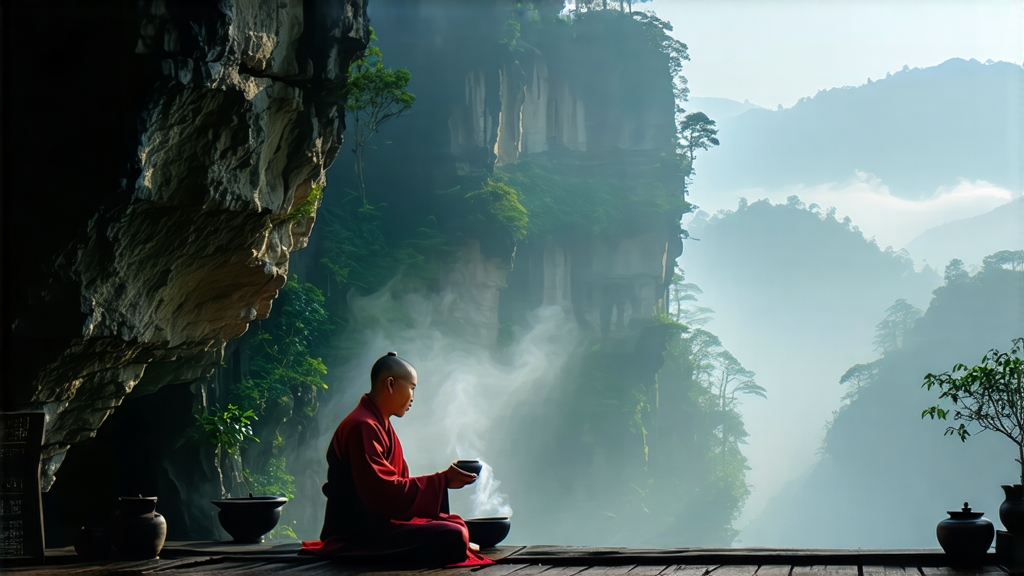
Da Hong Pao—literally “Big Red Robe”—is not merely a tea; it is a Chinese epic compressed into a leaf. Originating in the Wuyi Mountains of northern Fujian, this oolong carries the scent of pine-smoked gorges, the mineral bite of weathered cliffs, and the folklore of an imperial scholar whose life was saved by the brew. First recorded in the early Ming dynasty (14th c.), the original mother trees still stand on Jiulongke, their scarred trunks wrapped in red silk robes bestowed by grateful emperors. Only a handful of harvests were ever plucked from these six ancient bushes, making 20 grams of authentic mother-tree Da Hong Pao more valuable than gold. Today the genetic lineage survives through asexually propagated cuttings, ensuring that every sip of modern Da Hong Pao is a direct descendant of those 350-year-old ancestors.
Geologically, the Wuyi range is a playground for tea. Volcanic tuff, weathered granite and narrow gorges trap morning mists that act like a natural shade-cloth, slowing photosynthesis and concentrating aromatic oils. The locals call this terroir “rock rhyme” (yanyun): a lingering mineral sweetness that arrives after the swallow, like the echo of a bell inside a stone temple. No other oolong, not even the celebrated Taiwanese high-mountain varieties, can replicate this limestone-laced finish.
Da Hong Pao belongs to the “rock oolong” or yancha family, yet within that family it is further split into three commercial tiers. Qidan (Pure Breed) is cloned directly from the mother trees, yielding a focused, peppery cup. Beidou (North Star) is bred from cuttings taken in the 1980s, softer and orchid-like. Que-she (Sparrow Tongue), the rarest, is a micro-lot harvested from bushes grown in the narrowest crevices where goats fear to tread. Regardless of tier, all authentic Da Hong Pao must be grown inside the 60-square-kilometer UNESCO core zone; leaves picked beyond the protected buffer may legally be labeled “Wuyi oolong” but never “Da Hong Pao.”
Crafting Da Hong Pao is a choreography of fire, sweat and patience. Picking occurs only in late April, when three half-mature leaves still clasp a dormant bud. The pluckers work barefoot on bamboo scaffolds bolted to vertical cliffs, filling wicker baskets strapped to their foreheads. Once down the mountain, the leaves are withered on bamboo trays set over charcoal embers; the radiant heat drives off grassy volatiles while the leaf edges bruise against one another, initiating oxidation. At 30 % oxidation—halfway between green and black—the leaves are rolled into tight dragon-eyed strips and roasted three times over 90 days. The first roast is fierce, 120 °C for fifteen minutes, locking in the signature “charcoal heart.” Subsequent roasts drop 10 °C each cycle, allowing the inner moisture to migrate outward without scorching the leaf. A master roaster judges readiness by the sound: when the leaves hiss like a startled viper, the fire is tamed. The final tea rests in earthen jars for at least six months so the smoke can mellow into honey.
To brew Da Hong Pao gongfu style, begin with spring water whose hardness is below 80 ppm; calcium dulls rock rhyme. Pre-heat a 120 ml Yixing teapot made from zhuni clay; its high iron content amplifies minerality. Use 8 grams of leaf—roughly two heaping teaspoons—rinsed for three seconds to wake the dragon. The first proper infusion is flash-like, 5 seconds at 98 °C, yielding a pale apricot liquor that smells of toasted sesame and ripe longan. Each subsequent steep adds five seconds, revealing a kaleidoscope: osmanthus, nutmeg, wet slate, then finally a cooling camphor note that Chinese physicians liken to “opening the lung orifices.” A quality Da Hong Pao endures nine infusions before surrendering, the ninth tasting like river stones dipped in diluted honey.
Professional cupping follows a quieter ritual. Five grams are placed in a white porcelain gaiwan, 150 ml water at 100 °C, steeped three minutes. The liquor must be brilliant,